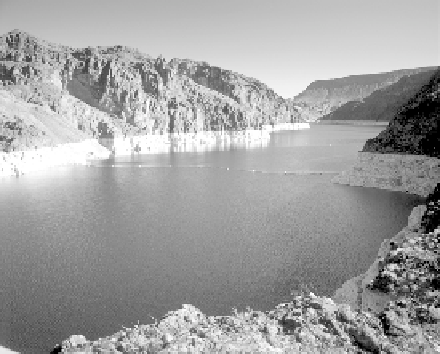Environmental Engineering Reference
In-Depth Information
FIGURE 15.5
Lake Mead. (From U.S. Bureau of Reclamation home page for the San Juan-Chama Project Colorado and
New Mexico, http://www.usbr.gov/projects/Project.jsp?proj_Name=San%20Juan-Chama%20Project, accessed
on July 15, 2011.) (Courtesy of the US Bureau of Reclamation.)
for declaring and sharing a shortage are important for all involved, but their importance for
the CAP, which delivers 1.5 million acre feet of water to three counties in Arizona, cannot be
overstated. The CAP, which had to agree to lowest priority of Colorado River users in order to
secure federal funding for the project, could suffer cutback of its entire allocation in times of
drought, adversely affecting the water supplies of Central Arizona cities, such as Tucson and
Phoenix.* Instead, under what are considered the most likely drought scenarios, this agree-
ment called for more frequent and therefore less severe cutbacks through 2026.
†
These guidelines do not cover all scenarios. River modeling is a complex task. It is
difficult to model things that have never occurred before. Recent research has focused on
the question of whether the Colorado River flows could diminish such that Lake Mead,
the storage reservoir for the Lower Basin States (Arizona, California, and Nevada), would
run dry (Figure 15.5). There is disagreement on the probabilities of this occurring, but
scientists have placed the probability at greater than zero.
‡
What is most challenging for planners is that paradigms for water modeling and therefore
water management have changed. In an oft-cited article in
Science
, seven scientists concluded
that approaches to data gathering and modeling must be adapted to incorporate fundamental
changes in climate.
42
They conclude that, in the face of the enormous challenges of renew-
ing decaying infrastructure and building new infrastructure, we must “update the analytic
strategies used for planning such grand investments under an uncertain and changing cli-
mate.” The lack of “stationarity” cited by the scientists essentially means that water planners
must consider new/more scenarios with greater unknowns.
§
If the scientists can change and
explain their enhanced approach to modeling, the water planners can better understand
*
Central Arizona Project.
38
†
Arizona began a system banking CAP water for future times of shortage in 1997. Therefore, planning for
drought on the Colorado River began well before the official shortage sharing guidelines were established.
‡
See Barnett and Pierce,
39
McKinnon,
40
and Myers.
41
§
The concept of stationarity is similar to what Alan Greenspan stated to Congress in the Fall of 2008 regarding
the economic models on which he based a lifetime of economic thinking. He stated that the economic melt-
down had left him in a “state of shocked disbelief.” He cited “a flaw in the model … that defines how the world
works.” See The Associated Press.
43

Search WWH ::

Custom Search